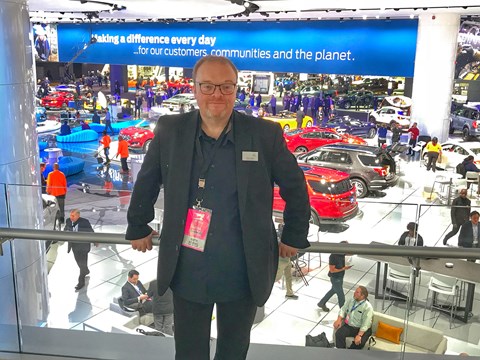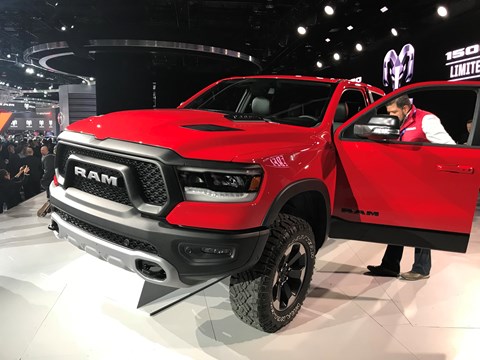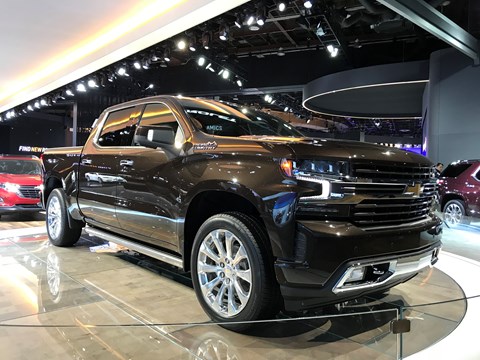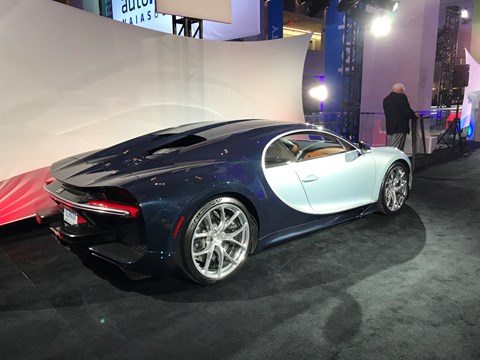► Detroit motor show 2018 review
► What rocked, and what flopped…
► Join our walkaround of the NAIAS
Coming to Detroit after a raft of European and Asian motor show feels like a journey into a parallel universe. Motown might be a fading force in the world’s automotive hierarchy, but as one industry exec said to me on the Ford stand, ‘we’re in great shape right now.’ But that’s all about the trucks.
And it has to be said that after the deep, deep problems that stemmed from the global banking crisis of 2008, the US market really is doing okay. Sales were down slightly in 2017, ending an eight-year growth spurt, but they only fell back to 2016 levels – still very strong.
Pick-up trucks and SUV/crossovers are the big success story, as conventional passenger cars are being overlooked.

So, the US business is doing well, but its flagship motor show less so. It’s fading, and under attack from a raft of Chinese events – Shanghai and Beijing have been joined by Guangzhao – and the domestic upstarts, Los Angeles, Chicago and New York, as well as the CES, which seems to get more new-car launches than anything else.
You could do a whistle-stop tour of the Detroit show in an hour, but to do so would mean missing some interesting stories.
Detroit motor show: Truck Wars, 2018 style
One gets the feeling that the lack of new metal at Detroit is as much about the state of the industry elsewhere as it is a reflection of the weakness of the USA’s big three.

You see, Mercedes-Benz might have hoped that the rebooted G-Wagen was the star of the show – I’ll get to that in a minute – but the truth is that with Ford, GM and FCA all unveiling new pick-up trucks, no one else got a look-in as far as the American media was concerned.
It’s easy for us Europeans to scoff at these super-sized beasts of burden. They’re dinosaurs from a previous age, we bleat. But in an age of continued navel-gazing over autonomy and electrification, these gloriously inappropriate vehicles and their multi-cylinder engines are actually something of a blessed relief. In 2017, full-sized pick-ups took 14% of the US market, and all of them will have blessed their makers with healthy margins.
That’s why I took in the Ram 1500 and Chevrolet Silverado press conferences on the show floor, and noted the fact that both have Brits behind them. You know what – they were easily the best attended, and most enthusiastically engaged. Truck Wars are raging in Detroit right now, and beyond the bluff exterior of these two there’s some very interesting efficiency-chasing tech to be found.

Both the Ram and Chevy are significantly lighter than their predecessors – the Silverado, for instance, has a Dynamic Fuel Management system that will probably filter across the rest of the car industry.
It’s a cylinder cut-off system that uses computers to randomly fire on the number of cylinders needed. It’s interesting stuff, and expect to hear a lot more of it in the future.
Mercedes-Benz’s unlikely show star: the G-class
To the cars, and there was a dearth of exciting launches. Mercedes-Benz scored a bullseye with the new G-Wagen, a situation helped by there being so few other product reveals to talk about. The styling of the new car has been pretty much left alone, while ability-enhancing tech means that it’s still a hard-core off-roader, and one that does very good business for Mercedes.
There was some talk about hybridisation, but Mercedes boss Dieter Zetsche said, ‘don’t forget we have other off-roaders for that.’

Nosing around the recently-launched Jeep Wrangler, and spending time with one highly enthusiastic member of its design team drew some interesting parallels – ‘you can’t f*ck up an icon,’ said another FCA employee.
The language was different, but Zetsche had said pretty much the same thing earlier. You get the feeling that these two companies really understand the iconic status of the G-Wagen and Wrangler. What was left hanging in the air was whether Land Rover will play the same strategy with the Defender when it surfaces later this year.
BMW was the best of the rest…
BMW brought the blink-and-you’ll-miss-it i8 facelift and brand-new Coupe roadster version, with it underlining its commitment to electrification. ‘We are confident that 2018 will another excellent year for BMW with a clear focus on electrification,’ said Bernhard Kuhnt, BMW’s North American boss.
But one got the impression that this wasn’t the place to say so. The BMW X2 potentially looks more interesting – and will certainly sell – but it seemed atypical of the SUV movement, rather than pushing it forward.
Detroit motor show: where were the concepts?
That’s how it felt with the concepts, too. They were out in Detroit, but not in force. Nissan, Lexus and Infiniti wheeled out electrified show cars that lacked any significant wow factor, as we’d seen it pretty much before – electrification, autonomy and emotional design can only be remixed so many times. Of the three, the most interesting was the Lexus LF-1, which hopefully signposts a move away from its maker’s current styling awkwardness.

The big three US makers were notably absent from unveiling anything concept-shaped, while the Chinese maker GAC tried to win column inches with its desperately generic Enverge show car. If it struggled here, imagine just how badly it would sink without a trace in Geneva. Perhaps that’s why GAC was here.
New cars, but so many not for us
Most of the big reveals were cars we’re not going to see in the UK. And in a way, that’s quite sad. The second-generation Hyundai Veloster looks nicely matured, and with a Biermann-honed chassis, it’s guaranteed to drive well but ‘absolutely, categorically isn’t coming to Europe’, while the new Honda Insight looked like a much more nicely resolved design than its rival the Toyota Prius (or indeed the 10th-generation Civic).
Do we care that the Toyota Avalon doesn’t come here? Probably not, but the interesting Nissan Kicks (below) should, as it looks like it would do well in SUV-obsessed Britain.

Actually, a thought for the good old saloon. Here in Detroit, it’s clear that just like everywhere else, this format is fading. And yet, some of the best-resolved designs right now are saloons.
The Americans, especially, have some great-looking three-boxes in production right now – and yet, the SUV is running roughshod over them all.
Supercars were plentiful in Detroit, but seemed to be here to act as little more than eye-candy. Everything from the Bugatti Chiron, Lamborghini Huracan Performante and Porsche 911 GT3 RS were all on show, but not in an official capacity.

None of these manufacturers had a stand at Detroit. But these absentees weren’t alone – we saw no sign of Brits Jaguar Land Rover, Bentley, McLaren or Rolls-Royce. Even MINI was reduced to a mere pair of its latest model. Ferrari was much-missed too.
Heck, even Tesla wasn’t here.
So, what did we learn in Detroit?
We learned that absenteeism really sums up the Detroit motor show. It’s a symbol of another era, an event that’s fading fast. Yet I love it, and somehow, it’s impossible to imagine an automotive season not opening here.
Ford, GM and FCA’s home show runs a very real risk of becoming an irrelevance on the global stage, and imagining a couple more European or Japanese pull-outs isn’t that difficult at all.
If that happens, NAIAS could do worse than become a very interesting commercial vehicle show…
Click here for a full A-Z of every car at the Detroit motor show